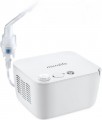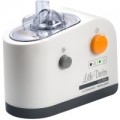Type
—
Ultrasonic. Ultrasonic nebulisers operate by vibrating a special plate to break the liquid into tiny droplets, typically around 5 microns or smaller. These small droplets easily penetrate even the narrowest bronchial passages, ensuring effective inhalation. The temperature of the "steam" aligns with the surrounding air, making the inhalation process comfortable. Ultrasonic atomization is highly efficient, providing a strong therapeutic effect with compact and nearly silent devices, even pocket-sized. However, they come with drawbacks, including a relatively high cost, limited range (nebulization element to mask distance of 10 — 15 cm), which can be inconvenient, especially with children. Additionally, some drugs are not suitable for ultrasonic spraying, as it may either be ineffective or damage the active substances.
—
Compressor. This type of nebuliser provides nebulization due to the operation of the compressor, which supplies a powerful stream of air to a container with a treatment solution. This allows you to create "cold steam" like that produced by the ultrasonic models described above. However compressor units are quite heavy; pocket models are less common among this type; and during operation they create a characteristic noise, which is why they are poorly suitable for small children. On the other hand, such devices are very versatile: in most cases, they are suitable for any type of inh
...aled drug, and they can also be equipped with devices for changing the particle size (see below).
— Salt. These nebulisers are specialized devices designed for inhaling "salty" air, mimicking the conditions found near the sea or in salt caves. These devices typically consist of specially shaped containers filled with healing salt, equipped with a protective filter to prevent the inhalation of salt grains. Inhaling through these nebulisers allows air to pass through the salt layer, becoming enriched with beneficial ions and micronutrients. Salt ones offer advantages such as compact size, no need for power, silent operation, and relatively low cost, with the bulk of the expense attributed to the salt filler. However, their drawback lies in their specific purpose — these devices are exclusively intended for salt inhalation and cannot be used for other substances.
— Steam. Nebulisers using the evaporation of a liquid through temperature, often known as "heat-moist", have a distinct feature: the inhaled substance is at a high temperature. This characteristic provides a unique thermal effect, but it comes with both advantages and disadvantages. Steam nebulisers offer a warmth not found in other types, yet they cannot be used when the body temperature is significantly elevated, and there is an extensive list of contraindications. Moreover, elevated temperatures can lead to the destruction of many medicinal substances, limiting the range of drugs suitable for steam inhalation. Additionally, these devices often produce larger droplets and are primarily effective for treating the upper respiratory tract.Medicine container
The nebuliser's built-in medicine reservoir volume is a crucial consideration. It's important to align this parameter with medical guidelines for the prescribed treatment. A too-small capacity may require frequent refilling, disrupting the treatment process.
Also, knowing the volume of the reservoir and the nebulization rate (see below), it is possible to estimate the operating time of the nebuliser on a single refill.
Compressor power
The power consumed by the compressor of the nebuliser during operation; in this case, it means not only the corresponding element of compressor models (see "Type"), but also the nebulizer in ultrasonic devices.
The performance and power consumption of the nebuliser depend on this parameter. The more powerful the compressor, the higher the possible air flow rate and, accordingly, nebulization. At the same time, powerful devices consume more power (which is especially important when powered offline, see below) and can generate quite a lot of noise.
Max air flow
The maximum air output of a compressor nebuliser during operation is a key factor to consider. It's important to note that actual performance during normal operation is often lower. Different applications have recommended air flow intensities, and knowing this parameter helps assess how well the inhaler aligns with specific recommendations.
Nebulization rate
The nebuliser's nebulization capacity per minute.
The ideal nebulization rate can differ based on factors such as the patient's health condition, the type of disease, and the composition of the inhaled medication, as outlined in medical guidelines. This rate is crucial in assessing the inhaler's effectiveness for specific situations and also influences how long the device operates on a single medication refill.
Some models have a nebulization speed control — in such cases, the maximum value is usually indicated in the characteristics.
Particle size
The aerosol generated by a nebuliser contains droplets of varying sizes. Smaller droplets have an easier time reaching the narrow passages of the bronchi, delivering the medicinal substance deeper into the respiratory system. For optimal therapeutic effects, it is recommended that droplet sizes do not surpass 5 microns. It's worth noting that during the atomization process, particles may vary in size, and their values are often expressed as a range.
Medium particle size (MMAD)
Since not all particles have the same size, this paragraph indicates exactly the average, most common particle size when splitting in this inhaler. Accordingly, lower values allow easier and deeper penetration into the bronchi.
Noise level
The nebuliser's maximum noise level during normal operation is a crucial factor for user comfort, especially in situations where loud sounds are undesirable, such as when treating children or during nighttime use. It's important to note that the relationship between decibel levels and actual perceived noise is not linear. For instance, a 3 dB increase corresponds to a doubling of noise, and a 20 dB increase equals a 100 — fold increase in noise. Comparative tables are often used to assess the actual loudness of inhalers, and here are some relevant values for modern devices:
30 dB — comparable to a whisper, the maximum permissible noise level in residential premises at night according to sanitary standards;
35 dB — talking in an undertone;
40 dB — normal speech at a distance of about 10 m;
45 dB — conversation in a normal voice;
50 dB — a conversation is slightly louder than usual, it is considered the maximum noise level that does not cause noticeable inconvenience;
55 dB — car engine;
60 dB — TV at medium volume;
65 dB — loud conversations at a distance of up to 1 m.
Nozzles
Types of nozzles included in the delivery of the nebuliser.
—
The mask for adult. A mask is a dual-purpose nozzle covering both the mouth and nose, typically secured with a strap. It ensures effective drug inhalation, accommodating variations in breathing patterns. Masks are versatile, suitable for use during sleep or unconsciousness. However, their larger size may hinder portability when carrying them with a nebuliser (refer to "Purpose"). Despite their convenience, specialized devices offer higher aerosol concentration. This type of mask is tailored for the average adult.
—
Children's mask. Reduced version of the mask, designed for children. The design may provide additional decorative elements (see "Appearance for children"), and in terms of functionality and main features, such masks do not differ from the adults described above.
—
Nozzle for nose. A drug delivery nozzle for the nose typically features a distinctive "fork" shape with two separate protrusions inserted into the nostrils. These protrusions may gently compress the nasal septum, ensuring comfortable usage. These devices are particularly effective for treating conditions focused on the nasal cavity, such as rhinitis, as they provide a higher medicine concentration compared to masks. Additionally, nasal nozzles are more compact for easy storage.
— Nozzle for mouth.
...An inhalation nozzle designed for drug administration through the mouth is a specialized device that offers a higher concentration of the active substance compared to a mask. This is particularly beneficial for intensive treatment of the oral cavity or larynx. Despite their small size, these nozzles are well-suited for use with pocket nebulisers. However, a drawback is the requirement for conscious patient participation, as they need to securely hold the tube with their lips and inhale through the mouth. While not as convenient as a mask, it somewhat restricts the application scope.
